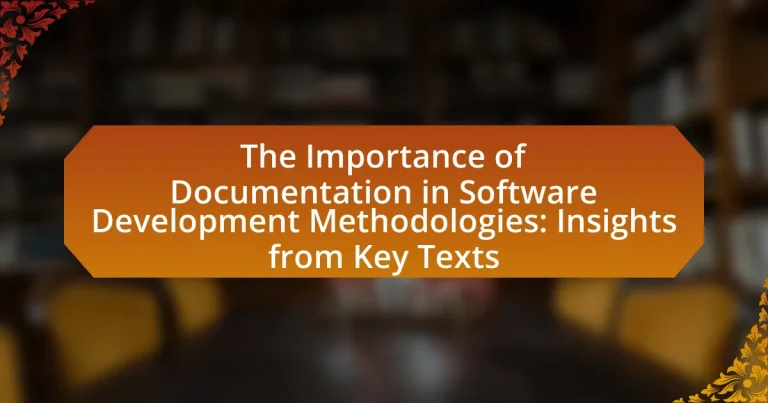The article focuses on the critical role of documentation in software development methodologies, emphasizing its importance for clear communication, knowledge transfer, and project management. It outlines various types of documentation, including requirements, design, technical, user, and maintenance documentation, and discusses the differences between technical and user documentation. The article also highlights the challenges associated with maintaining accurate and up-to-date documentation, the impact of effective documentation on software quality and maintainability, and best practices for ensuring documentation remains relevant. Insights from key texts and case studies further reinforce the necessity of comprehensive documentation in enhancing team collaboration and project success.

What is the Importance of Documentation in Software Development Methodologies?
Documentation is crucial in software development methodologies as it ensures clear communication, facilitates knowledge transfer, and provides a reference for future maintenance. Clear documentation helps teams understand project requirements, design decisions, and implementation details, reducing misunderstandings and errors. Furthermore, it serves as a historical record that aids in onboarding new team members and supports ongoing project evolution. Studies show that well-documented projects experience 25% fewer defects, highlighting the tangible benefits of thorough documentation practices in enhancing software quality and team efficiency.
Why is documentation considered essential in software development?
Documentation is considered essential in software development because it provides a clear and comprehensive reference for developers, stakeholders, and users. This clarity facilitates effective communication, ensures consistency in coding practices, and aids in onboarding new team members. According to the IEEE Standard for Software Documentation, proper documentation can reduce maintenance costs by up to 30% by enabling easier updates and modifications. Furthermore, studies show that well-documented projects are 25% more likely to succeed, as they help mitigate risks associated with knowledge transfer and project continuity.
What role does documentation play in project management?
Documentation plays a critical role in project management by providing a structured framework for communication, tracking progress, and ensuring accountability. It serves as a reference point for project goals, timelines, and deliverables, which helps in aligning team efforts and managing stakeholder expectations. According to the Project Management Institute, effective documentation can reduce project risk and improve project outcomes by 20-30%. This highlights the importance of maintaining clear and comprehensive records throughout the project lifecycle to facilitate informed decision-making and enhance collaboration among team members.
How does documentation facilitate communication among team members?
Documentation facilitates communication among team members by providing a clear and consistent reference point for project information, decisions, and processes. This clarity reduces misunderstandings and ensures that all team members are aligned on objectives and methodologies. For instance, a study by the Project Management Institute found that effective documentation can improve project success rates by up to 20%, highlighting its role in enhancing team collaboration and reducing errors.
What types of documentation are commonly used in software development?
Common types of documentation used in software development include requirements documentation, design documentation, technical documentation, user documentation, and maintenance documentation. Requirements documentation outlines the functionalities and constraints of the software, while design documentation details the architecture and components. Technical documentation provides information on the codebase and APIs, and user documentation assists end-users in understanding how to use the software. Maintenance documentation supports ongoing updates and troubleshooting. Each type serves a distinct purpose, ensuring clarity and efficiency throughout the software development lifecycle.
What are the differences between technical and user documentation?
Technical documentation provides detailed information about the software’s architecture, design, and functionality, primarily aimed at developers and engineers. In contrast, user documentation focuses on guiding end-users on how to effectively use the software, emphasizing usability and practical instructions. Technical documentation often includes API references, system requirements, and troubleshooting guides, while user documentation typically features user manuals, FAQs, and tutorials. The distinction lies in the target audience and purpose: technical documentation is for those building or maintaining the software, whereas user documentation is for those utilizing it.
How do agile methodologies approach documentation compared to traditional methods?
Agile methodologies prioritize lightweight, flexible documentation that evolves with the project, contrasting with traditional methods that emphasize comprehensive, static documentation. In agile practices, documentation serves as a tool for communication and collaboration, focusing on essential information that supports the development process rather than exhaustive records. For instance, the Agile Manifesto values “working software over comprehensive documentation,” highlighting the belief that documentation should be just enough to facilitate understanding and progress. This approach allows teams to adapt quickly to changes and fosters continuous feedback, which is less feasible in traditional methodologies that often rely on extensive upfront documentation and rigid processes.
What challenges are associated with documentation in software development?
Documentation in software development faces several challenges, including maintaining accuracy, ensuring clarity, and keeping it up-to-date. These challenges arise because software projects often evolve rapidly, leading to discrepancies between the code and its documentation. For instance, a study by the IEEE found that 40% of software projects experience documentation that is outdated or inconsistent with the current codebase. Additionally, developers may struggle to write clear documentation due to varying levels of technical expertise among team members, which can result in misunderstandings or misinterpretations. Furthermore, the time constraints in agile methodologies often lead to insufficient documentation practices, as teams prioritize coding over writing. These factors collectively hinder effective communication and knowledge transfer within development teams.
How can outdated documentation impact a project?
Outdated documentation can severely hinder a project’s progress and success. When documentation does not reflect the current state of the project, team members may rely on incorrect or obsolete information, leading to errors in implementation and increased development time. A study by the Project Management Institute found that poor documentation practices can result in project delays of up to 30%, as teams spend additional time clarifying requirements and correcting mistakes. Furthermore, outdated documentation can create knowledge silos, where new team members struggle to understand the project context, ultimately affecting collaboration and productivity.
What are common pitfalls in creating effective documentation?
Common pitfalls in creating effective documentation include lack of clarity, insufficient detail, and failure to update content. Lack of clarity often results from using jargon or overly complex language, making it difficult for users to understand the material. Insufficient detail can lead to gaps in information, leaving users without the necessary context or instructions to complete tasks. Additionally, failure to update documentation regularly can render it obsolete, as software and processes evolve, leading to confusion and errors. Research indicates that 70% of users abandon documentation due to these issues, highlighting the critical need for clear, detailed, and current documentation in software development methodologies.
How can effective documentation improve software quality?
Effective documentation improves software quality by providing clear guidelines and standards that enhance communication among team members. When documentation is thorough and well-structured, it reduces misunderstandings and errors during the development process, leading to fewer bugs and higher overall software reliability. Research indicates that projects with comprehensive documentation experience a 30% reduction in development time and a 25% decrease in post-release defects, as teams can refer to established protocols and requirements. This structured approach not only streamlines the development workflow but also facilitates onboarding for new team members, ensuring that they can quickly understand the project context and contribute effectively.
What impact does documentation have on code maintainability?
Documentation significantly enhances code maintainability by providing clear guidelines and context for developers. Well-structured documentation allows new and existing team members to understand the codebase quickly, reducing the time needed for onboarding and troubleshooting. According to a study by the IEEE, projects with comprehensive documentation experience a 30% reduction in maintenance time compared to those with minimal documentation. This efficiency stems from the ability to reference design decisions, usage examples, and potential pitfalls, which collectively streamline the debugging and updating processes.
How does documentation contribute to reducing technical debt?
Documentation contributes to reducing technical debt by providing clear guidelines and context for code, which facilitates better understanding and maintenance. When developers have access to comprehensive documentation, they can more easily identify and address issues, leading to fewer shortcuts and workarounds that typically accumulate as technical debt. Studies show that teams with well-maintained documentation experience a 30% reduction in onboarding time for new developers, which directly correlates with lower technical debt as new team members can quickly understand existing systems and avoid introducing errors.
What insights can be drawn from key texts on documentation in software development?
Key texts on documentation in software development emphasize its critical role in enhancing communication, ensuring knowledge transfer, and facilitating project management. For instance, “The Pragmatic Programmer” by Andrew Hunt and David Thomas highlights that effective documentation serves as a bridge between developers and stakeholders, reducing misunderstandings and aligning expectations. Additionally, “Clean Code” by Robert C. Martin underscores that well-documented code improves maintainability and fosters collaboration among team members. These insights collectively affirm that comprehensive documentation is essential for successful software development, as it not only aids in onboarding new team members but also supports long-term project sustainability.
Which authors or texts are considered foundational in this area?
Foundational authors in the area of documentation in software development methodologies include Frederick Brooks, whose text “The Mythical Man-Month” emphasizes the importance of communication and documentation in project management. Another key figure is Tom DeMarco, known for “Peopleware,” which discusses the role of documentation in team dynamics and productivity. Additionally, the Agile Manifesto, authored by a group of software developers including Kent Beck and Martin Fowler, highlights the significance of documentation in agile methodologies. These texts collectively underscore the critical role of documentation in enhancing software development processes and team collaboration.
What lessons can be learned from case studies on documentation practices?
Case studies on documentation practices reveal that effective documentation enhances communication, reduces errors, and improves project outcomes. For instance, a study by the Standish Group found that projects with comprehensive documentation are 30% more likely to succeed compared to those with minimal documentation. Additionally, case studies demonstrate that clear documentation facilitates onboarding and knowledge transfer, as evidenced by a report from the Project Management Institute, which states that organizations with well-documented processes experience a 20% increase in team productivity. These insights underscore the critical role of documentation in software development methodologies.
How can teams implement best practices for documentation?
Teams can implement best practices for documentation by establishing clear guidelines and utilizing collaborative tools. Clear guidelines should include standardized formats, naming conventions, and version control to ensure consistency and accessibility. Collaborative tools, such as Confluence or Google Docs, facilitate real-time updates and feedback, enhancing team communication. Research indicates that organizations with structured documentation practices experience a 25% increase in project efficiency, as noted in the “State of Documentation” report by the Documentation Strategy Conference. This evidence supports the effectiveness of implementing best practices in documentation.
What tools and technologies can aid in effective documentation?
Effective documentation can be aided by tools and technologies such as Confluence, Microsoft OneNote, Google Docs, and Markdown editors. Confluence facilitates collaborative documentation with features for version control and integration with other Atlassian products, making it suitable for software development teams. Microsoft OneNote offers a flexible note-taking environment that supports multimedia content, enhancing the documentation process. Google Docs allows real-time collaboration and easy sharing, which is essential for teams working remotely. Markdown editors provide a lightweight markup language that simplifies formatting and enhances readability, making it easier to create structured documents. These tools collectively improve the efficiency and clarity of documentation in software development methodologies.
How can teams ensure documentation remains up-to-date and relevant?
Teams can ensure documentation remains up-to-date and relevant by implementing regular review cycles and assigning ownership for specific documents. Establishing a schedule for periodic reviews, such as quarterly or after major project milestones, allows teams to assess the accuracy and completeness of documentation. Additionally, designating team members as document owners ensures accountability, as they are responsible for updating content based on project changes or feedback. Research indicates that organizations with structured documentation practices experience a 25% increase in project efficiency, highlighting the importance of maintaining current documentation.
What are practical tips for improving documentation in software development?
To improve documentation in software development, teams should adopt clear and consistent formatting, utilize version control for documentation, and encourage regular updates. Clear formatting enhances readability and comprehension, making it easier for developers to find and understand information. Version control ensures that documentation evolves alongside the codebase, allowing for tracking changes and maintaining historical context. Regular updates, ideally integrated into the development workflow, ensure that documentation remains relevant and accurate, which is crucial for effective collaboration and onboarding. Research indicates that teams with well-maintained documentation experience a 50% reduction in onboarding time for new developers, highlighting the tangible benefits of these practices.


